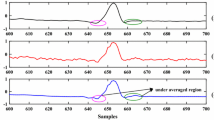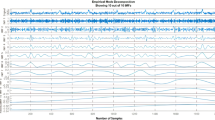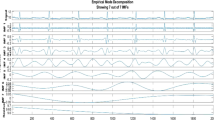Abstract
In this paper, we propose a novel ECG signal enhancement method based on Complete Ensemble Empirical Mode Decomposition with Adaptive Noise (CEEMDAN) and Higher Order Statistics (HOS). In our scheme, the noisy ECG signal is first decomposed adaptively into oscillatory components called intrinsic mode functions (IMFs) by using Empirical Mode Decomposition (EMD) or its variants. Therefore, the obtained modes are separated into two groups of noisy signal modes and one group of useful signal modes, by using a novel criterion derived from the HOS namely the fourth order cumulant or kurtosis. After that, a modified shrinkage scheme based on Interval Thresholding technique is adaptively applied to each selected IMF from the noise-dominant groups in order to reduce the noise and to preserve the QRS complex. The overall filtered ECG signal is then reconstructed by combining the thresholded IMFs and the retained unprocessed lower frequency relevant IMFs. Various tests and simulations are investigated to evaluate the performance of our proposed approach in combination with the EMD, Ensemble EMD (EEMD) and CEEMDAN algorithms. The simulation results carried on MIT-BIH Arrhythmia database, show that CEEMDAN method gives better performance than the two other methods, and outperforms some state-of-the-art methods in terms of Signal to Noise Ratio (SNR) and Root Mean Square Error (RMSE).












Similar content being viewed by others
Notes
The kurtosis function does not subtract 3 from the computed value as in (14).
It was founded, after several repetitive simulations, that a rarely occurred problem can be shown when the boundaries K4jmax and K4js are consecutive. In this case, the HIT is now applied to the second set of IMFs.
In our scheme, we have used the Stationary Wavelet Transform (SWT) [29].
The choice is justified by the great similarity between ′db4′ and QRS complex shape.
By using the Inverse Stationary Wavelet Transform (ISWT).
To be in the same conditions to [11], the number of iterations is fixed to 200 with a 0.2 standard deviation for white Gaussian noise.
The denoising principle in [6] is re-implemented by discarding only the first two IMFs.
ECG record amplitudes are not divided by the the amplification gain of 200 for the MITDB.
References
Alfaouri M, Daqrouq K (2008) ECG Signal denoising by wavelet transform thresholding. Am J Appl Sci 5:276–281
Analyse Of Variance (ANOVA). [Online]. Available: https://www.mathworks.com/help/stats/anova1.html
Ari S, Das MK, Chacko A (2013) ECG Signal enhancement using S-transform. Comput Biol Med 43(6):649–660
Blanco-Velasco M, Weng B, Barner K (2008) ECG Signal denoising and baseline wander correction based on the empirical mode decomposition. Comput Biol Med 38(1):1–13
Boudraa AO, Cexus JC (2007) EMD-Based signal filtering. IEEE Trans Instrum Meas 56(6):2196–2202
Chang KM, Liu SH (2011) Gaussian noise filtering from ECG by wiener filter and ensemble empirical mode decomposition. J. Signal Process. Syst. 64(2):249–264
Chawla M (2009) A comparative analysis of principal component and independent component techniques for electrocardiograms. Neural Comput Appl, Springer-Verlag Lond Limited 18:539–556
Clifford GD, Azuaje F, McSharry PE (2006) Advanced Methods and Tools for ECG Data Analysis. Artech House Engineering in Medicine & Biology Series
Donoho D (1995) De-noising by soft-thresholding. IEEE Trans Inf Theory 41 (3):613–627
EL bouny L, Khalil M, Adib A (2017) ECG Noise Reduction Based on Stationary Wavelet Transform and Zero-Crossings Interval Thresholding. In: IEEE ICEIT International Conference. Rabat. Morocco
EL Bouny L, Khalil M, Adib A (2017) ECG Signal Denoising Based on Ensemble EMD Thresholding and Higher Order Statistics. In: 3th IEEE International Conference on Advanced Technologies for Signal and Image Processing (ATSIP’2017), Morocco
El Hamdouni N, Adib A, Larbi S, Turki M (2013) Blind digital audio watermarking scheme based on EMD and UISA techniques. J Multimed Tools Appl, Springer 64(3):809–829
Ercelebi E (2004) Electrocardiogram signals de-noising using lifting-based discrete wavelet transform. Comput Biol Med 34(6):479–493
Flandrin P, Goncalves P, Rilling G (2004) Detrending and denoising with empirical mode decompositions. In: European Signal Processing Conference (EUSIPCO), pp 1581–1584
George T, Xenos D (2011) Signal denoising using empirical mode decomposition and higher order statistics. Int J Signal Process Image Process Pattern Recogn 4 (2):91–106
He T, Clifford G, Tarassenko L (2006) Application of ICA in removing artefacts from the ECG. Neural Process Lett 15:105–116
Huang NE et al (1998) The empirical mode decomposition method and the Hilbert spectrum for non-stationary time series analysis. In: Royal Society London, pp 903–995
Hong H, Liang M (2007) K-Hybrid: A Kurtosis-Based hybrid thresholding method for mechanical signal denoising. Trans ASME J Vib Acoust 129:458–470
Kabir M d A, Shahnaz C (2012) Denoising of ECG signals based on noise reduction algorithms in EMD and wavelet domains. Biomed Signal Process Control 7:481–489
Khalil M, El Hamdouni N, Adib A (2012) Increasing the information Capacity and Improving the detection reliability in audio watermarking system. International Symposium on Communications, Control and Signal Processing (ISCCSP). Rome, Italie
Khaldi K et al (2008) Speech Signal Noise Reduction by EMD. In: proceeding International Symposium on Communications, Control and Signal Processing (ISCCSP). Malta, pp 1155–1185
Khaldi K, Boudraa AO, Bouchikhi A, Turki M (2008) Speech enhancement via EMD. EURASIP. J Adv Signal Process 2008:1–8
Komaty A, Boudraa AO, Dare D (2012) EMD-Based filtering using the Hausdorff distance. In: Proceeding IEEE ISSPIT, pp 1–12
Komaty A, Boudraa AO, Augier B, Dare D (2014) EMD-Based Filtering Using Similarity Measure Between Probability Density Functions of IMFs. IEEE Trans Instrum Meas 63(1):27–34
Kopsinis Y, McLaughlin S (2009) Development of EMD-based denoising methods inspired by wavelet thresholding. IEEE Trans Signal Process 57:1351–1362
Kopsinis Y, McLaughlin S (2008) Empirical mode decomposition based soft-thresholding. In: proceeding of 16th European Signal Processing Conference (EUSIPCO), pp 1–5
Maniruzzaman M, Kazi M, Billah S, Biswas U, Gain B (2012) Least-Mean-Square algorithm based adaptive filters for removing power line interference from ECG signal. In International conference on Informatics, Electronics & Vision
MIT-BIH-Arrhythmia Database. Available at: http://www.physionet.org/physiobank
Nason G, Silverman B (1995) The stationary wavelet transform and some statistical applications. Wavelets Stat Lect Notes Stat-Springer Verlag 103:281–299
Nguyen P, Kim JM (2016) Adaptive ECG Denoising Using Genetic Algorithm-Based Thresholding and Ensemble Empirical Mode Decomposition. Inf. Sci. https://doi.org/10.1016/j.ins.2016.09.033
Poornachandra S (2008) Wavelet-based denoising using subband dependent threshold for ECG signals. Digit Signal Process 18(1):49–55
Rani S (2011) Comparative study of FIR and IIR filters for the removal of Baseline noises from ECG signal. Int J Comput Sci Inform Technol 2(3):1105–1108
Rilling G, Flandrin P, Goncalves P (2009) Empirical mode decomposition as a filter bank. IEEE Signal Process Lett 11(11):112–114
Sameni R et al (2007) A nonlinear bayesian filtering framework for ECG denoising. IEEE Trans. Biomed. Eng. 54:1–14
Sayadi O, Shamsollahi MB (2006) ECG denoising with adaptive bionic wavelet transform. In: 28 th IEEE EMBS Annual International Conference. New York City, USA
Sharma LN, Dandapat S, Mahanta A (2010) ECG Signal denoising using higher order statistics in wavelet subbands. Biomed Signal Process Control, Elsevier 5:214–222
Suchetha M, Kumaravel N (2013) Empirical mode decomposition based filtering techniques for powerline interference reduction in electrocardiogram using various adaptive structures and subtraction methods. Biomed Signal Process Control 8:575–585
Tompkins A (2007) EMD-Based 60 Hz Noise Filtering of The ECG. In: 29 th IEEE EMBS Annual International Conference, pp 1904–1907
Torres ME, Colominas MA, Schlotthauer G, Flandrin P (2011) A complete ensemble empirical mode decomposition with adaptive noise. In: IEEE international conference on acoustic, Speech and Signal Processing (ICASSP), pp 4144–4147
Wu Z, Huang NE (2004) A study of the characteristics of white noise using the empirical mode decomposition method. In: Proceeding of Royal Society London, pp 1597–1611
Wu Z, Huang NE (2009) Ensemble Empirical Mode Decomposition: a noise-assisted data analysis method. Adv Adapt Data Anal 1(1):1–41
Yang G, Yuanyuan L, Yanyong W, Zhanlong Z (2015) EMD Interval thresholding denoising based on similarity measure to select relevant mode. Signal Process 109:95–109
Acknowledgements
The authors would like to thank the editorial office Christian Malan, the editor-in-chief, the guest editors as well as the anonymous reviewers for their valuable comments and suggestions that helped to very much improve the quality of this paper.
This research was supported by the National Center for Scientific and Technical Research of Morocco (CNRST) (grant number : 148UH22017).
Author information
Authors and Affiliations
Corresponding author
Rights and permissions
About this article
Cite this article
El Bouny, L., Khalil, M. & Adib, A. ECG signal filtering based on CEEMDAN with hybrid interval thresholding and higher order statistics to select relevant modes. Multimed Tools Appl 78, 13067–13089 (2019). https://doi.org/10.1007/s11042-018-6143-x
Received:
Revised:
Accepted:
Published:
Issue Date:
DOI: https://doi.org/10.1007/s11042-018-6143-x




